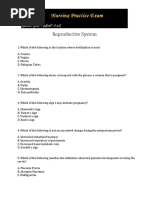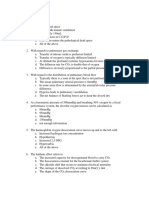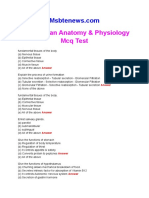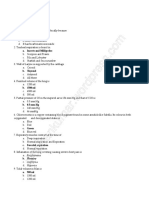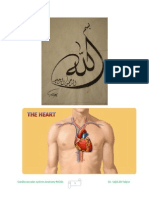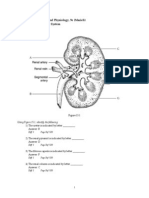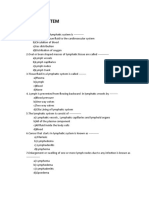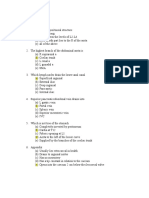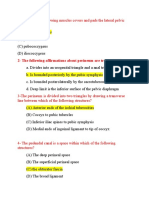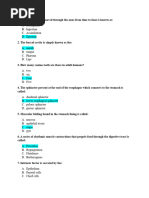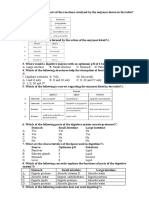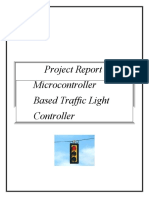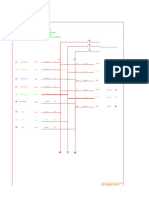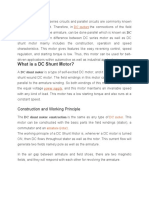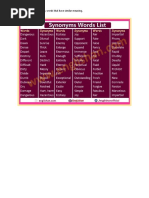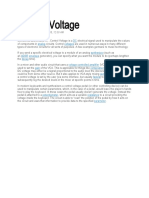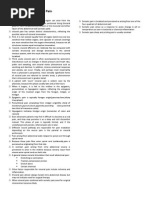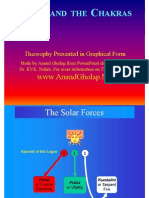100%(17)100% found this document useful (17 votes)
21K viewsMCQs of Digestive System
MCQs of Digestive System
Uploaded by
الموعظة الحسنه chanelThis document contains 20 multiple choice questions and 10 true/false questions about the digestive system. The questions cover topics like the largest salivary gland, number of deciduous teeth, portions of the stomach, secretions of parietal cells, subdivisions of the small intestine, histology of the large intestine, hormones that stimulate bile release, accessory organs, and locations of digestion. It provides an assessment of knowledge about the major organs and functions of the digestive system.
Copyright:
© All Rights Reserved
Available Formats
Download as DOCX, PDF, TXT or read online from Scribd
MCQs of Digestive System
MCQs of Digestive System
Uploaded by
الموعظة الحسنه chanel100%(17)100% found this document useful (17 votes)
21K views4 pagesThis document contains 20 multiple choice questions and 10 true/false questions about the digestive system. The questions cover topics like the largest salivary gland, number of deciduous teeth, portions of the stomach, secretions of parietal cells, subdivisions of the small intestine, histology of the large intestine, hormones that stimulate bile release, accessory organs, and locations of digestion. It provides an assessment of knowledge about the major organs and functions of the digestive system.
Original Description:
lll
Copyright
© © All Rights Reserved
Available Formats
DOCX, PDF, TXT or read online from Scribd
Share this document
Did you find this document useful?
Is this content inappropriate?
This document contains 20 multiple choice questions and 10 true/false questions about the digestive system. The questions cover topics like the largest salivary gland, number of deciduous teeth, portions of the stomach, secretions of parietal cells, subdivisions of the small intestine, histology of the large intestine, hormones that stimulate bile release, accessory organs, and locations of digestion. It provides an assessment of knowledge about the major organs and functions of the digestive system.
Copyright:
© All Rights Reserved
Available Formats
Download as DOCX, PDF, TXT or read online from Scribd
Download as docx, pdf, or txt
100%(17)100% found this document useful (17 votes)
21K views4 pagesMCQs of Digestive System
MCQs of Digestive System
Uploaded by
الموعظة الحسنه chanelThis document contains 20 multiple choice questions and 10 true/false questions about the digestive system. The questions cover topics like the largest salivary gland, number of deciduous teeth, portions of the stomach, secretions of parietal cells, subdivisions of the small intestine, histology of the large intestine, hormones that stimulate bile release, accessory organs, and locations of digestion. It provides an assessment of knowledge about the major organs and functions of the digestive system.
Copyright:
© All Rights Reserved
Available Formats
Download as DOCX, PDF, TXT or read online from Scribd
Download as docx, pdf, or txt
You are on page 1of 4
Chapter 19 The Digestive System
Multiple Choice Questions
1. The largest salivary gland is which of the following?
A. Parotid
B. Submandibular
C. Sublingual
D. Pharyngeal
2. How many deciduous teeth are usually present?
A. 10
B. 20
C. 30
D. 32
3. Which portion of the stomach opens into the duodenum?
A. Cardia
B. Body
C. Pyloric canal
D. Fundus
4. Parietal cells secrete hydrochloric acid and ________.
A. Intrinsic factor
B. Pepsin
C. Gastrin
D. Pepsinogen
5. The ________ is the region of the stomach, which extends to the entrance to the
duodenum and whose muscular sphincter regulates the passage of materials into the
duodenum.
A. Antrum
B. Pylorus
C. Body
D. Cardia
6. The longest portion of the small intestine is the ________.
A. Duodenum
B. Jejunum
C. Ileum
D. Colon
7. Which of the following increases the surface area for digestion and absorption in the
mucosa of the small intestine?
A. Teniae coli
B. Rugae
C. Omenta
D. Microvilli
8. The majority of nutrient absorption occurs in which subdivision of the small intestine?
A. Ileum
B. Duodenum
C. Cardia
D. Jejunum
9. Which subdivision of the small intestine is connected to the pylorus?
A. Duodenum
B. Jejunum
C. Body
D. Ileum
10. Intestinal glands contain ________ cells which are responsible for the production of
several intestinal hormones.
A. Enteroendocrine
B. Chief
C. Oxyntic
D. Parietal
11. Which statement regarding the histology of the large intestine is TRUE?
A. The wall of the large intestine is thicker than that of the small intestine.
B. The large intestine lacks villi.
C. There are fewer goblet cells in the large intestine compared to the small intestine.
D. There is no longitudinal muscle layer present.
12. Bile ejection from the gallbladder occurs under stimulation of the hormone ________,
which is released into the bloodstream at the duodenum when chyme arrives containing
large amounts of lipids and partially digested proteins.
A. Gastrin
B. Cholecystokinin
C. Secretin
D. Intrinsic factor
13. Problems caused by reduced bile secretion may include ________.
A. Constipation
B. Appendicitis
C. A reduced ability to digest lipids
D. Decreased protein digestion in the jejunum
14. Which of the following are functions of the gallbladder?
A. Secretion of cholecystokinin
B. Secretion of gastrin
C. Storage and modification of bile
D. Breakdown of erythrocytes
15. The accessory pancreatic duct empties into which structure?
A. Stomach
B. Jejunum
C. Cecum
D. Duodenum
16. Which of the following is an accessory digestive organ?
A. Pharynx
B. Esophagus
C. Large intestine
D. Pancreas
17. Which of the following organs that mechanical digestion occurs?
A. Stomach
B. Small intestine
C. Esophagus
D. Mouth
18. Regarding the boundaries of the oral cavity which one is not TRUE?
A. Tongue anteriorly
B. Cheeks laterally
C. Palate superiorly
D. Fauces of oropharynx posteriorly
19. Which of the following is the first part of large intestine?
A. Cecum
B. Colon
C. Appendix
D. Rectum
20. Which of the following organs produces bile?
A. Liver
B. Gallbladder
C. Pancreas
D. Spleen
True or False Questions
1. The deciduous teeth first appear by the age of 2 years
A. True
B. False
2. Wisdom tooth is out of the 32 permanent teeth
A. True
B. False
3. Enamel is the strongest substance in our body
A. True
B. False
4. Pyloric sphincter prevents stomach acid from entering esophagus
A. True
B. False
5. Absorption of water and electrolytes occurs in large intestine
A. True
B. False
6. The liver is the largest gland in the body
A. True
B. False
7. Endocrine part of pancreas is ductless and produces hormones that regulate blood sugar.
A. True
B. False
8. The inferior third of the esophageal muscularis mucosae consists of only smooth muscle
A. True
B. False
9. Parietal cells secrete pepsinogen and hydrochloric acid
A. True
B. False
10. Fundus is a region of stomach that is superior to the gastroesophageal junction
A. True
B. False
You might also like
- Reproductive SystemDocument5 pagesReproductive SystemHCX dghhq100% (2)
- Respiratory Respiratory Physiology (MCQS)Document2 pagesRespiratory Respiratory Physiology (MCQS)atefmabood100% (12)
- Physiology MCQ - RespiratoryDocument14 pagesPhysiology MCQ - RespiratoryJoseph95% (21)
- Physiology MCQ - Blood PDFDocument4 pagesPhysiology MCQ - Blood PDFJoseph100% (10)
- MCQs On Circulation Physiology With KeyDocument6 pagesMCQs On Circulation Physiology With KeyMudassar Roomi92% (37)
- MCQ Introduction of Anatomy 2013-2014 by Dr. Noura PDFDocument3 pagesMCQ Introduction of Anatomy 2013-2014 by Dr. Noura PDFFaddy Oraha77% (26)
- Anatomy & Physiology Mcqs Solved-1Document42 pagesAnatomy & Physiology Mcqs Solved-1Sana Rasheed100% (3)
- Urinary System MCQDocument12 pagesUrinary System MCQshaiyrkul kasmambetova100% (4)
- Anatomy: Axial Skeleton MCQS: C SphenoidDocument8 pagesAnatomy: Axial Skeleton MCQS: C SphenoidTahir Aziz75% (4)
- The Lymphatic System - Test QuestionsDocument4 pagesThe Lymphatic System - Test Questionsflorin100% (8)
- The Nervous System MCQ'sDocument6 pagesThe Nervous System MCQ'sTahir Aziz100% (10)
- Human Anatomy and Physiology MCQ With Answers PDFDocument4 pagesHuman Anatomy and Physiology MCQ With Answers PDFPrince Maurya90% (10)
- Thorax MCQs PDFDocument7 pagesThorax MCQs PDFOmar Nuhic100% (4)
- Multiple-Choice Questions: Chapter 49 Nervous SystemsDocument10 pagesMultiple-Choice Questions: Chapter 49 Nervous SystemsTrajce100% (3)
- Robbins Basic Pathology 9th Edition QBankDocument4 pagesRobbins Basic Pathology 9th Edition QBankVarshini Tamil Selvan0% (1)
- Abdo & PelvisDocument15 pagesAbdo & PelvisAbid Khan100% (1)
- Abdomen Mcqs With AnswersDocument10 pagesAbdomen Mcqs With AnswersKumar KP75% (16)
- Muscle MCQs - AnswerDocument41 pagesMuscle MCQs - AnswerMohit Balboa90% (80)
- Hillson Et Al. 2005Document14 pagesHillson Et Al. 2005Aurelien TafaniNo ratings yet
- 018 Physiology MCQ ACEM Primary GITDocument4 pages018 Physiology MCQ ACEM Primary GITSereen Abd El-rahman89% (9)
- Endocrine System MCQDocument19 pagesEndocrine System MCQBijay Kumar Mahato50% (2)
- Respiration 1 MCQ 12 Nos With Key PDFDocument8 pagesRespiration 1 MCQ 12 Nos With Key PDFAnonymous fn9zdHU7100% (5)
- Cardiovascular System Anatomy McqsDocument9 pagesCardiovascular System Anatomy McqsDr. Sajid Ali Talpur81% (32)
- 5 - Physiology MCQ Body Fluids & HormonesDocument5 pages5 - Physiology MCQ Body Fluids & Hormonesaboody omer100% (1)
- Physiology MCQ - Muscles and NervesDocument10 pagesPhysiology MCQ - Muscles and NervesJoseph91% (11)
- MCQS OF RESPIRATORY SYSTEM - DetailDocument3 pagesMCQS OF RESPIRATORY SYSTEM - Detailhashmat ali75% (4)
- Test - Embryology Practice Questions With Answers - QuizletDocument10 pagesTest - Embryology Practice Questions With Answers - QuizletAziz100% (1)
- The Urinary System - Test QuestionsDocument4 pagesThe Urinary System - Test QuestionsflorinNo ratings yet
- Abdomen Mcqs PDFDocument32 pagesAbdomen Mcqs PDFKai Lago100% (2)
- MCQ (Endocrine)Document7 pagesMCQ (Endocrine)aminata680% (5)
- Study Questions Urinary SystemDocument32 pagesStudy Questions Urinary Systemandy_jean_2100% (2)
- Hbs Nervous System TGDocument21 pagesHbs Nervous System TGSumita AroraNo ratings yet
- Git MCQ New 5Document16 pagesGit MCQ New 5Omar H100% (6)
- Digestion 2 MCQDocument6 pagesDigestion 2 MCQgopod71% (7)
- Digestive System Exam IIDocument13 pagesDigestive System Exam IIhugomiso100% (3)
- Chapter 43 Reproductive Systems: Multiple Choice QuestionsDocument23 pagesChapter 43 Reproductive Systems: Multiple Choice QuestionsAnonymous Azxx3Kp9100% (1)
- Anatomy MCQsDocument22 pagesAnatomy MCQsRashid Hussain82% (11)
- Digestion 1 MCQDocument11 pagesDigestion 1 MCQgopod0% (1)
- Endocrine System McqsDocument7 pagesEndocrine System McqsRakhi Lal100% (2)
- Renal MCQ 1Document2 pagesRenal MCQ 1Aziz100% (2)
- Skeletal System MCQsDocument4 pagesSkeletal System MCQsTahir Aziz75% (8)
- Lymphatic System MCQsDocument3 pagesLymphatic System MCQsNimra82% (11)
- The Digestive System MCQSDocument4 pagesThe Digestive System MCQSTahir Aziz100% (1)
- GITDocument43 pagesGITMohamed HaridyNo ratings yet
- Renal MCQ 4Document10 pagesRenal MCQ 4Aziz100% (1)
- Endocrine System - Life Sciences Questions and Answers - SanfoundryDocument8 pagesEndocrine System - Life Sciences Questions and Answers - SanfoundryHUAWEI HUAWEINo ratings yet
- Body FluidsDocument7 pagesBody FluidsNivya Mary100% (1)
- Digestive System Multiple Choice QuizDocument11 pagesDigestive System Multiple Choice QuizJerilee SoCute Watts100% (1)
- MCQ GenitourinaryDocument3 pagesMCQ Genitourinaryanojan100% (6)
- MINERALS MCQsDocument6 pagesMINERALS MCQsNasirNo ratings yet
- Physiology MCQ - EndocrineDocument8 pagesPhysiology MCQ - EndocrineSana Almosawi100% (2)
- Gi Physiology Mcqs 24 Aug 04Document7 pagesGi Physiology Mcqs 24 Aug 04Ran Acc100% (1)
- MCQ On ErythropoiesisDocument6 pagesMCQ On ErythropoiesisIrekton GG100% (1)
- Anatomy MCQ - Abdomen - 2Document15 pagesAnatomy MCQ - Abdomen - 2ahsan gujjar100% (1)
- MCQ PerineumDocument4 pagesMCQ PerineumEman Hamada100% (2)
- Quiz MEDSERGDocument5 pagesQuiz MEDSERGRose RanadaNo ratings yet
- The Digestive System Summative Test - Q3 - M1Document2 pagesThe Digestive System Summative Test - Q3 - M1Metchel100% (2)
- digestive system P5 multiple choice (1)Document3 pagesdigestive system P5 multiple choice (1)seth feanorNo ratings yet
- Unit-4 (Life Processes (Nutrition+Gas Exchange)Document3 pagesUnit-4 (Life Processes (Nutrition+Gas Exchange)naeemluni14No ratings yet
- Digestion Test BiologyDocument3 pagesDigestion Test BiologyKatrīna SimanovskaNo ratings yet
- Key For NatSci 2 Prefinal ExamDocument4 pagesKey For NatSci 2 Prefinal ExamManongdo AllanNo ratings yet
- Kenn-Exam Science A DoneDocument6 pagesKenn-Exam Science A DoneBernice OrtegaNo ratings yet
- Grade 10 Biology Final Exam 1Document8 pagesGrade 10 Biology Final Exam 1shongdynasty41No ratings yet
- Email: Tell: 618451886/617333478Document1 pageEmail: Tell: 618451886/617333478الموعظة الحسنه chanelNo ratings yet
- Project Report On Microcontroller Based Traffic Light ControllerDocument23 pagesProject Report On Microcontroller Based Traffic Light Controllerالموعظة الحسنه chanelNo ratings yet
- 3x16mm2 One Run in PVC Pipe of 20mm: Lights 8px100w 800W 3x1.5mm2 6A AC5 1.2KW 3x4mm2 20ADocument1 page3x16mm2 One Run in PVC Pipe of 20mm: Lights 8px100w 800W 3x1.5mm2 6A AC5 1.2KW 3x4mm2 20Aالموعظة الحسنه chanelNo ratings yet
- Presentation of Traffic Light ControllerDocument11 pagesPresentation of Traffic Light Controllerالموعظة الحسنه chanelNo ratings yet
- Sub: Ethics Lecturer: ENG - ABTIYOOW Headline: Lack of Controlling and Lack of PrivacyDocument16 pagesSub: Ethics Lecturer: ENG - ABTIYOOW Headline: Lack of Controlling and Lack of Privacyالموعظة الحسنه chanelNo ratings yet
- Powerpoint Lesson 1 Microsoft Powerpoint BasicsDocument42 pagesPowerpoint Lesson 1 Microsoft Powerpoint Basicsالموعظة الحسنه chanelNo ratings yet
- Drop Test For R:: Circuit Diagram For Load Test On D.C. Compound GeneratorDocument4 pagesDrop Test For R:: Circuit Diagram For Load Test On D.C. Compound Generatorالموعظة الحسنه chanelNo ratings yet
- Fundamental EliminationDocument27 pagesFundamental Eliminationالموعظة الحسنه chanelNo ratings yet
- What Is A DC Shunt Motor?: Shunt Motor. The Main Difference Between DC Series Motor As Well As DCDocument3 pagesWhat Is A DC Shunt Motor?: Shunt Motor. The Main Difference Between DC Series Motor As Well As DCالموعظة الحسنه chanelNo ratings yet
- Synonyms RevisionDocument1 pageSynonyms Revisionالموعظة الحسنه chanelNo ratings yet
- REVISION ON SYNONMYS Words That Have Similar MeaningDocument1 pageREVISION ON SYNONMYS Words That Have Similar Meaningالموعظة الحسنه chanelNo ratings yet
- Control VoltageDocument1 pageControl Voltageالموعظة الحسنه chanelNo ratings yet
- What Is A DC Shunt Motor?: Shunt Motor. The Main Difference Between DC Series Motor As Well As DCDocument3 pagesWhat Is A DC Shunt Motor?: Shunt Motor. The Main Difference Between DC Series Motor As Well As DCالموعظة الحسنه chanelNo ratings yet
- Electrical Machines and DrivesDocument33 pagesElectrical Machines and Drivesالموعظة الحسنه chanelNo ratings yet
- Question 1: As Shown in Figure 1. A 6-Pole, Long-Shunt Lap-Wound CompoundDocument4 pagesQuestion 1: As Shown in Figure 1. A 6-Pole, Long-Shunt Lap-Wound Compoundالموعظة الحسنه chanelNo ratings yet
- Praktikum ICD 10 FixxDocument4 pagesPraktikum ICD 10 FixxHardLine GAMINGNo ratings yet
- The Inman Aligner For Anterior Tooth Alignment: OrthodonticsDocument6 pagesThe Inman Aligner For Anterior Tooth Alignment: OrthodonticsJoe FlechNo ratings yet
- Importance of Blood DonationDocument3 pagesImportance of Blood Donationahm4040No ratings yet
- Visceral Pain and Somatic PainDocument1 pageVisceral Pain and Somatic PainPandu HarsarapamaNo ratings yet
- Blood Supply of The Heart & Conduction System: Dr. Nabil KhouriDocument37 pagesBlood Supply of The Heart & Conduction System: Dr. Nabil KhouriDefyna Dwi LestariNo ratings yet
- Chemistry Project On Estimation of Contant of Bone Ash PDFDocument9 pagesChemistry Project On Estimation of Contant of Bone Ash PDFPooja BhagwatNo ratings yet
- Ilmu Reproduksi TernakDocument29 pagesIlmu Reproduksi TernakMoh ikbal Dwi PutraNo ratings yet
- Chapter 11 Blood ReviewerDocument4 pagesChapter 11 Blood ReviewerPhilline ReyesNo ratings yet
- Chakras Book FromDocument22 pagesChakras Book FromLindsey SpencerNo ratings yet
- MBT 2Document11 pagesMBT 2NaveenNo ratings yet
- Mandibular Movements: Mayank Sharma Under The Guidance Of: DR - PujaDocument72 pagesMandibular Movements: Mayank Sharma Under The Guidance Of: DR - PujaAnuj Kumar Verma100% (1)
- MenstruationDocument1 pageMenstruationPerrilyn PereyNo ratings yet
- Bahasa Inggris Tugas Cardiology SystemDocument5 pagesBahasa Inggris Tugas Cardiology SystemDohand CharelNo ratings yet
- Pathophysiology of Addison'S Disease: Non-Modifiable Factors: Modifiable FactorsDocument2 pagesPathophysiology of Addison'S Disease: Non-Modifiable Factors: Modifiable FactorsHanna NocumNo ratings yet
- JC Neutral ZoneDocument41 pagesJC Neutral ZoneDr. Eepsa MukhopadhyayNo ratings yet
- Activity Sheet in Science 5 Second Quarter Activity Sheet 2Document4 pagesActivity Sheet in Science 5 Second Quarter Activity Sheet 2dinnes masubay100% (3)
- P5 Exercise 4Document18 pagesP5 Exercise 4Richard AllenNo ratings yet
- Bio Toxin PathwayDocument1 pageBio Toxin PathwayJackie De Vries100% (1)
- Tongue Diagnosis Made EasyDocument9 pagesTongue Diagnosis Made EasyelibunNo ratings yet
- Lymphatic Drainage of The ThoraxDocument1 pageLymphatic Drainage of The ThoraxYusri ArifNo ratings yet
- 3.3 Fish Pituitary GlandDocument12 pages3.3 Fish Pituitary GlandOla Joel Ajamu0% (1)
- Chap 27 Examination of Thyroid GlandDocument18 pagesChap 27 Examination of Thyroid GlandJaaydevNo ratings yet
- Balancing Ramps in Nonanatomic Complete DentureDocument3 pagesBalancing Ramps in Nonanatomic Complete DentureDron Lakhani100% (4)
- Poultry Anatomy and PhysiologyDocument40 pagesPoultry Anatomy and PhysiologyMamtaNo ratings yet
- Endocrine MCQDocument3 pagesEndocrine MCQBenjamin Nelson100% (1)
- Endocrine SystemDocument42 pagesEndocrine SystemBio CheNo ratings yet
- Endocrine System PathologyDocument57 pagesEndocrine System PathologyCARSON 539No ratings yet
